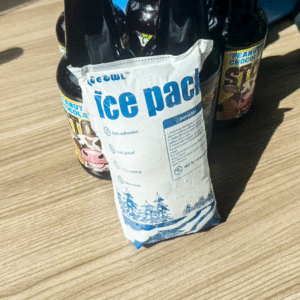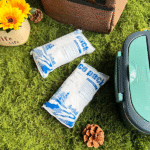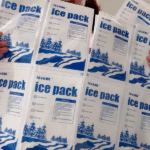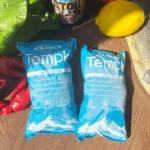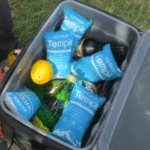Pack d'expédition de glace sec: How to Size and Label in 2025
If you need a dry ice shipping pack that actually stays frozen, start by sizing dry ice to transit hours, choisir la bonne isolation, and printing UN 1845 with net kilograms on a vented box. Most lanes work with 5–10 lb par 24 heures plus un tampon de 24 heures, et 2025 checklists require clear labels and vent paths for CO₂.
-
How much dry ice per day keeps goods frozen on your lane (avec une calculatrice copier-coller).
-
What to print on the label so carriers accept your dry ice shipping pack the first time.
-
When to choose gel/PCM instead of a dry ice shipping pack to simplify air shipments.
-
Which insulation (PSE, Pur, VIP) right‑sizes cost and mass for 24–120 h routes.
Qu'est-ce qu'un dry ice shipping pack et quand faut-il l'utiliser?
Réponse courte: UN dry ice shipping pack is a vented, insulated parcel that keeps payloads rock‑solid frozen using solid CO₂ (sublimes at −78.5 °C). Use it when your product must arrive fully frozen end‑to‑end; otherwise consider gel/PCM if chilled control is enough. Marque «Dioxyde de glace sèche / carbone, solide,»Et1845, et net kg, and ensure gas can vent.
Pourquoi ça compte pour toi: Venting prevents pressure buildup; correct markings speed acceptance and reduce delays. 2025 acceptance materials emphasize airline‑specific limits and providing net weight at booking, alors que USPS caps domestic air mail at ≤5 lb per piece and prohibits international mail with dry ice. If your lane is short or only needs chilled ranges, a gel/PCM pack avoids hazmat steps.
Dry ice shipping pack vs. gel/PCM—what fits your lane?
Choose a dry ice shipping pack when you need deep‑frozen conditions or ultracold lanes; choisir gel/PCM when you need 2–8 °C or moderate frozen (Par exemple, −15 ° C) with simpler paperwork. Larger pellets or blocks sublimate slower for multi‑day routes; tiny pellets are better for fast pull‑down.
| Option | Temp capability | Patrie (air) | Ce que cela signifie pour vous |
|---|---|---|---|
| Dry ice shipping pack | ≈ −78.5 °C surface | Oui | Tenues longues; ultracold lanes; étiquette & évent requis. |
| PCM −21°C / −26 °C bricks | Congelé (−15 to −26) | Généralement non | Easier processing; réutilisable; pas ultrafroid. |
| 0 Venir ° C / +5 ° C PCM | 2–8 ° C | Non | Marchandises réfrigérées; simple returns. |
Conseils pratiques que vous pouvez utiliser aujourd'hui
-
For DTC frozen food: Pré-Chill à l'expéditeur; place product low, glace sèche au-dessus; remplir les vides; laisser les bouches d'aération dégagées.
-
For hot lanes (été): Utiliser le high end of 5–10 lb/day and consider PUR or VIP insulation.
-
Pour les produits biologiques: Add a data logger and record glace sèche nette en kg on the label before tender.
Cas réel: A pastry brand cut melted‑product claims by 38% after switching to a 2‑inch liner, larger pellets, and a 24‑hour buffer—ice spend stayed flat while failures plummeted.
How much dry ice should a dry ice shipping pack carry?
Règle: Plan ~5 à 10 livres (2.3–4,5 kg) par 24 heures de transit plus an extra 24 heures for buffer. Commencer à proximité 7.5 lb / jour and adjust for insulation, chaleur ambiante, taille, and whether the box is opened mid‑route.
Pourquoi ça marche: Dry ice absorbs substantial heat while subliming (≈570 kJ/kg), so modest masses can cover a day or two in a tight shipper. Box R‑value, espace de tête, and pellet size drive real‑world loss rates.
Quick planner table
| Temps de transit | Glace sèche typique (kg) | Notes |
|---|---|---|
| 12–24 h | 5–10 | Thick foam → 5; summer lanes → 10. |
| 24–48 h | 10–20 | Prefer larger pellets for slower loss. |
| 72 h | 20–30 | Consider bigger box or added liner. |
| 96 h | 30–40 | Validate with a lane test before scale. |
How should you label a dry ice shipping pack in 2025?
Print this on one panel (same surface as Class 9 when size allows):
Et 1845
Dioxyde de carbone, solide (Glace sèche)
Glace carbonique nette: ____ kg
Expéditeur: ____________________
Destinataire: ____________________
Pour air, appliquer le Diamant de classe9, Continuez à emballage ventilé, and follow IATA Pi954. Airlines may impose additional limits and ask for net weight at booking. USPS permis ≤5 lb domestic air under PI 9A and prohibits international mail. Passenger flights allow ≤2.5 kg per person/package with airline approval and venting.
How do you pack out a dry ice shipping pack step by step?
-
Préchauffeur product and shipper to reduce the day‑one heat load.
-
Doubler & isolate: add a poly liner and absorbent pad; place a tray to avoid direct contact.
-
Charger: product low, glace sèche au-dessus; fill voids to reduce convection.
-
Fermer & secouer: never seal the outer box airtight; keep gas paths clear of tape.
-
Étiquette & book: marque Et1845 avec Kg net, ajouter Classe9 pour l'air, et suivre le 2025 liste de contrôle d'acceptation.
Safety and ventilation: CO₂ limits to respect
La neige carbonique devient du gaz CO₂. Indoors or in vehicles, gas can accumulate. Keep rooms ventilated and train staff. Reference limits: 5,000 ppm twa et 30,000 PPM Stel; add CO₂ alarms in staging areas. Always use insulated gloves and eye protection.
Which insulation and pellet size fit your dry ice shipping pack?
Pick insulation for duration et pellet size for endurance. EPS works for short lanes; PUR and VIP cut heat gain for 48–120 h routes and allow less refrigerant mass. Larger pellets or slabs sublimate slower on multi‑day lanes.
| Type de paquet | Typical window | Notes | Signification pour vous |
|---|---|---|---|
| PSE (1–2″) | 24–48 h | Lowest R‑value; lowest cost | Good for short lanes; plus de neige carbonique nécessaire. |
| Pur | 48–96 h | Higher R/inch; cohérent | Reduce mass and carton size. |
| VIP | 72–120 h+ | Very high performance | Longues voies, high value payloads; lighter overall. |
2025 trends shaping your dry ice shipping pack
Quoi de neuf 2025: IATA’s 66th Edition Addenda 1 (effective Apr 30, 2025) highlights airline‑specific dry ice limits and net weight at booking; carriers refreshed job aids stressing Class 9 placement with the Proper Shipping Name. USPS kept the ≤5 lb domestic air capuchon. VIP adoption keeps rising to trim refrigerant mass and freight.
Derniers développements en un coup d'œil
-
Clearer acceptance paperwork: Fewer dock delays if you mirror the 2025 liste de contrôle.
-
Preprinted cartons: More boxes ship with dry‑ice panels to reduce pack errors.
-
Perspectives du marché: Several reports project ~7–7.4% CAGR for dry ice through 2032, led by food and healthcare demand.
Perspicacité du marché: Near‑shoring and recyclable materials are trending, while IoT loggers make lane validation simpler and faster for audits.
Questions fréquemment posées
How much dry ice per day for a small dry ice shipping pack?
Plan 5–10 lb par 24 heures, puis ajouter un jour supplémentaire as buffer; use more for hot lanes or thin walls.
What must appear on my label in 2025?
Inclure Et1845, "Glace sèche / dioxyde de carbone, solide,» net dry ice in kilograms, expéditeur / destinataire, et Classe9; garder le colis aéré.
Can passengers carry a dry ice shipping pack?
Oui, ≤ 2,5 kg (5.5 kg) per person/package with airline approval; mark and vent the container.
Can I mail a dry ice shipping pack via USPS?
Air domestique uniquement, ≤5 lb par envoi postal; international mail is not allowed.
Is dry ice regulated for ground?
With some services (Par exemple, certain ground networks), dry ice isn’t hazmat—but markings are still required. Check your carrier page for specifics.
When should I pick PCM instead of a dry ice shipping pack?
Choisir −15 °C to −26 °C PCM for many frozen lanes or 0 °C gel/+5 °C PCM for 2–8 °C when you want easier processing and reuse.
Résumé & recommandations
Souviens-toi: Dimensionnez votre dry ice shipping pack par time first (5–10 lb / jour + 24Tampon d'une heure), then select insulation (EPS → PUR → VIP) et taille de granulée. Vent the box, imprimer Et1845 avec Kg net, and place Classe9 par 2025 conseils. Former les équipes sur Exposition au coré limits and stage packs in ventilated zones.
Étapes suivantes:
-
Estimate dry ice with the calculator above. 2) Print a label block with Et1845 et Kg net. 3) Pilot two shipments and weigh post‑delivery to tune mass. 4) Ajoutez le 2025 liste de contrôle d'acceptation to your SOP.
À propos du tempk
We’re a cold‑chain engineering team that turns complex transport requirements into simple packout SOPs. We validate dry ice shipping pack designs lane‑by‑lane, right‑size coolant loads, and provide label templates that pass first‑time acceptance. Customers in food and life sciences routinely cut claims by double digits while lowering re‑ship costs. Prêt à expédier plus froid, plus sûr, moins cher? Demander un 15‑minute packout review and get a route‑specific BOM, étiquettes, and a tested ice calculator.






